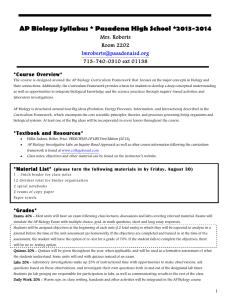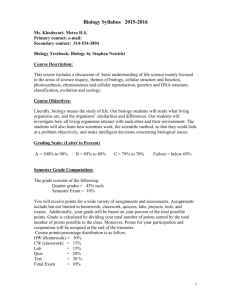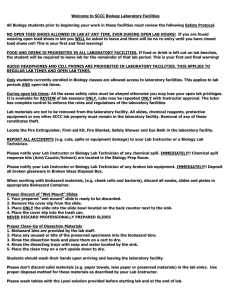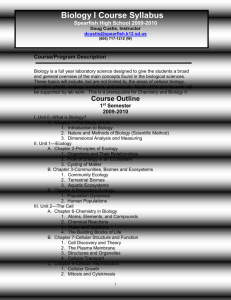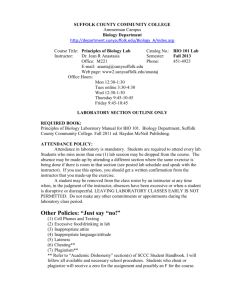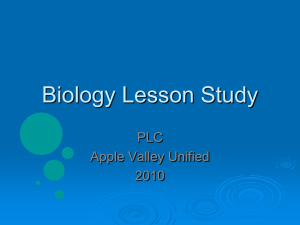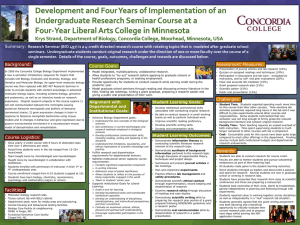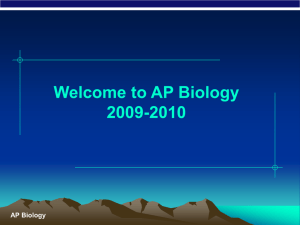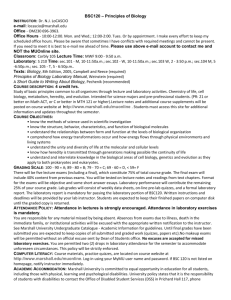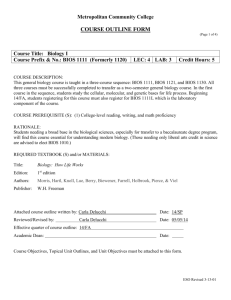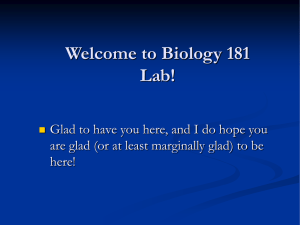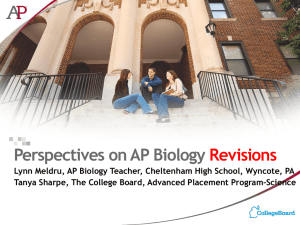Biology for NonScience Majors I A statewide Online Initiative
advertisement
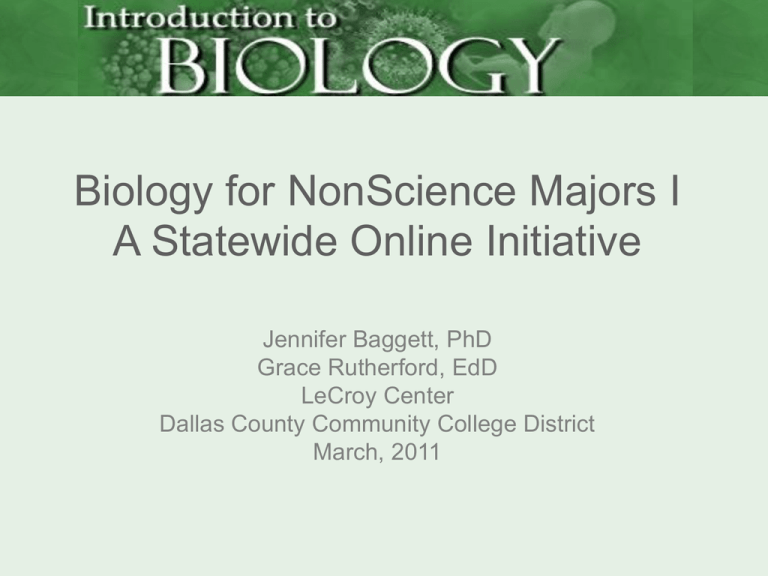
Biology for NonScience Majors I A Statewide Online Initiative Jennifer Baggett, PhD Grace Rutherford, EdD LeCroy Center Dallas County Community College District March, 2011 Why teach biology online? • • • • Meet student demand Improve student outcomes Increase student access Reduce costs Sloan Survey of Online Learning (2010): Surveyed 2,500 colleges and universities in the fall of 2009: • 5.6 million students were enrolled in one or more online courses. • 29% of students were taking at least one course online. http://sloanconsortium.org/ Sloan Consortium, Eighth Annual Report. Allen, E., & Seaman, J. (2010). Staying the Course: Online Education in the United States, Sloan-C, Needham, MA. Why teach biology online? • • • • Meet student demand Improve student outcomes Increase student access Reduce costs U.S. Department of Education (2010): “Learning outcomes for students who engaged in online learning exceeded those of students receiving face-to-face instruction…” (p. xiv) http://www2.ed.gov/about/offices/list/os/technology/techreports.html U.S. Dept. of Education, Office of Planning, Evaluation, and Policy Development, Evaluation of Evidence-Based Practices in Online Learning: A Meta-Analysis and Review of Online Learning Studies, Washington, D.C., 2010. Why teach biology online? • • • • Meet student demand Improve student outcomes Increase student access Reduce costs U.S. Department of Education (2006-7): Factors most relevant to college decisions about distance education: • Meeting student demand for flexible schedules • Increasing course availability (# sections) • Increasing student access to college • Increasing student enrollment http://nces.ed.gov/ Parsad, B., and Lewis, L. (2008). Distance Education at Degree-Granting Postsecondary Institutions: 2006–07 (NCES 2009–044). U.S. Department of Education, National Center for Education Statistics. Why teach biology online? • • • • Meet student demand Improve student outcomes Increase student access Reduce costs • Classroom space • Lab space • Lab materials • Instructor to student ratios Why not use a virtual lab? National Science Teachers Association Position Statement (NSTA, 2007): “While reading about science, using computer simulations, and observing teacher demonstrations may be valuable, they are not a substitute for laboratory investigations by students.” “At the college level, all students should have opportunities to experience inquiry-based science laboratory investigations…” http://www.nsta.org/about/positions/laboratory.aspx National Science Teachers Association Position Statement on The Integral Role of Laboratory Investigations in Science Instruction, adopted February 2007. What is this project about? • • • • • • Creation of Biology 1408 course template Free to all Texas community colleges Increase student learning and retention Decrease institutional costs of hosting biology labs Decrease instructor development time Almost “ready-to-go” course for a last-minute section to be taught for first time by faculty member Project Background • College Participation – Virtual College of Texas – TX Community College Teachers’ Association – Advisory Committee • Course Development – LeCroy Center • Lead Content Expert • Instructional Designer – McGraw-Hill – SoftChalk Platform What makes a great course? • The instructor • Clear, consistent, and relatable course materials Research • Areas important for student satisfaction with online instruction: – Interaction among students – Quality and timely interaction between student and professor – Consistent course design – Technical support – Flexibility of online courses compared to face-to-face Source: Young & Norgard (2006) Assessing the quality of online courses from the students' perspective Student-Content Interaction • 15 Lessons – Lesson Summaries – Animations – Interactives • 15 Labs correlate with lessons – Demonstration videos – Kit with lab manual Instructional Design • • • • • Engage learner Student orientation Clear and intuitive navigation Consistent course design Guided learning modules with – clear learning objectives – built-in self-assessment • Lab partner guiding students through lab experiments by video demonstration Instructor Support: Faculty Guide • • • • • Syllabus template Orientation template Suggested discussion questions Suggested research and interactive activities Supplemental test bank Measuring Success - Evaluation 1. Define learning outcomes 2. Design assessments • • Lecture content Lab practicals 3. Administer assessments to: • • • Face-to-face students Hybrid students with traditional lab Online students with at-home lab kit 4. Evaluate and share results Contact Information • Jennifer Baggett jenniferbaggett@dcccd.edu • Grace Rutherford grutherford@dcccd.edu For more information about acquiring this course, contact: • Becky Stinson bstinson@dcccd.edu



